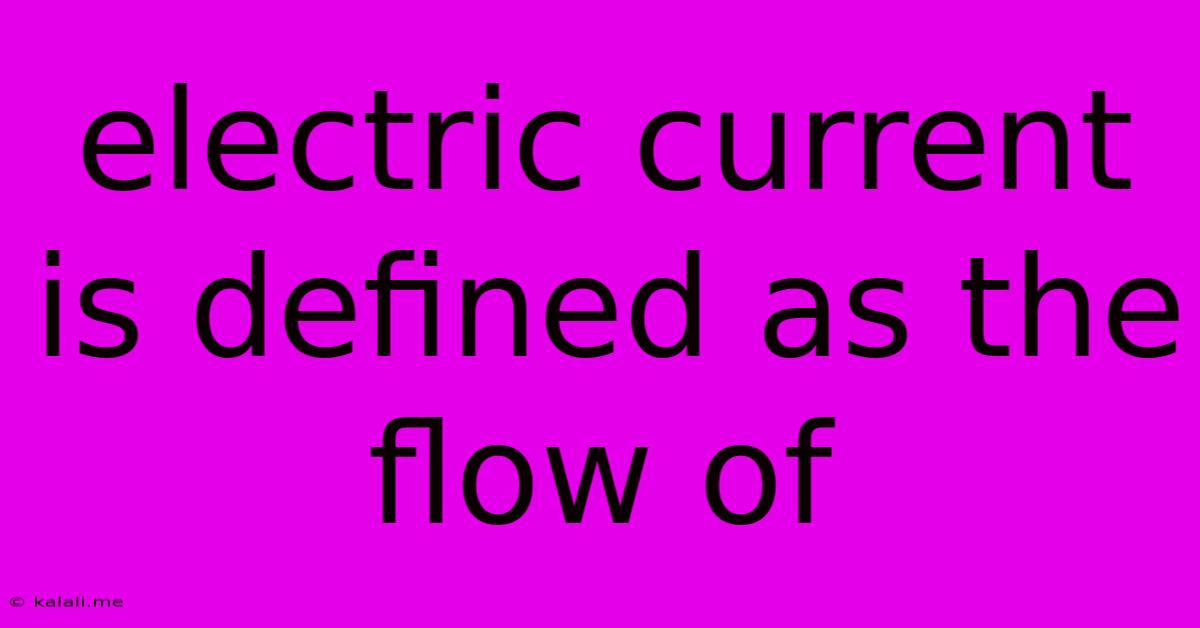Electric Current Is Defined As The Flow Of
Kalali
Jun 14, 2025 · 3 min read

Table of Contents
Electric Current: Defined as the Flow of Electric Charge
Electric current, a fundamental concept in physics and electrical engineering, is defined as the flow of electric charge. This seemingly simple definition opens the door to a fascinating world of electricity, powering everything from our smartphones to the national grid. Understanding what constitutes this flow, how it's measured, and its various applications is crucial to grasping the principles of electricity.
What exactly is flowing?
The "electric charge" in the definition refers to the movement of charged particles. In most common scenarios, this involves the movement of electrons. Electrons are negatively charged subatomic particles found orbiting the nucleus of an atom. However, it's important to note that other charged particles, such as ions (atoms with a net positive or negative charge), can also contribute to electric current in certain situations, like in electrolytes used in batteries.
How does it flow?
Electric charge doesn't flow randomly; it requires a conductive pathway. Materials are classified as conductors, semiconductors, or insulators based on their ability to allow electric charge to flow. Conductors, like copper wires, readily allow the flow of electrons, while insulators, such as rubber, significantly impede this flow. Semiconductors, like silicon, fall somewhere in between, exhibiting conductivity that can be controlled. The flow of electrons through a conductor is often visualized as a drift, a slow net movement in a specific direction, superimposed on the much faster random thermal motion of the electrons themselves.
Measuring Electric Current
Electric current is measured in amperes (A), often shortened to "amps." One ampere is defined as the flow of one coulomb of charge per second. A coulomb (C) is a unit of electric charge, representing approximately 6.24 x 10<sup>18</sup> electrons. Therefore, a current of one ampere means a huge number of electrons are passing a given point in the circuit every second. This seemingly large number is necessary to produce even small amounts of current, illustrating the minuscule charge of a single electron.
Types of Electric Current
There are two primary types of electric current:
-
Direct Current (DC): In DC, the electric charge flows in only one direction. Batteries are a common source of DC power, providing a constant voltage and unidirectional current flow. DC is often used in portable electronic devices and many low-voltage applications.
-
Alternating Current (AC): In AC, the direction of charge flow periodically reverses. Household electrical outlets typically supply AC power, with the current alternating direction many times per second (typically 50 or 60 Hz). AC is advantageous for long-distance power transmission due to its ease of voltage transformation.
Applications of Electric Current
Electric current is the backbone of modern technology, powering an astonishing array of devices and systems. From the smallest integrated circuits to the largest power grids, the controlled flow of electric charge drives our world. Examples include:
- Lighting: Incandescent, fluorescent, and LED lights all rely on electric current to produce illumination.
- Heating and Cooling: Electric heating systems and air conditioners utilize electric current to generate heat or move refrigerant.
- Computing and Electronics: Computers, smartphones, and countless other electronic devices function based on the manipulation of electric current in integrated circuits.
- Motor Operation: Electric motors, found in everything from fans to electric vehicles, convert electrical energy into mechanical energy using electric current.
Understanding the definition of electric current – the flow of electric charge – provides a foundation for comprehending a wide range of electrical phenomena and technological advancements. The principles described here serve as the basis for more complex concepts in electricity and electronics.
Latest Posts
Latest Posts
-
Difference Between An Estuary And A Delta
Jun 15, 2025
-
The Coordinates Of A Moving Particle
Jun 15, 2025
-
Parts Of A Spark Plug Diagram
Jun 15, 2025
-
Which Statements Are True Regarding Glycolipids
Jun 15, 2025
-
What Is The Cube Root Of 81
Jun 15, 2025
Related Post
Thank you for visiting our website which covers about Electric Current Is Defined As The Flow Of . We hope the information provided has been useful to you. Feel free to contact us if you have any questions or need further assistance. See you next time and don't miss to bookmark.